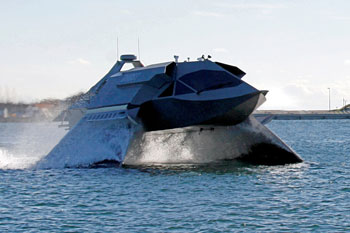The Front Lines of Fast
Fishermen’s Voice Staff

The Ghost during sea trials at Portsmouth, NH. Expected to do 80 knots. The vessel is powered by turbine driven propellers on the front end of two submerged pontoons. Supercavitation around these pontoons enables extrordinary speed in a vessel this size and weight. JMS Photo
Recent innovations in the quest for speed and efficiency on the water have brought together disparate naval and other technologies. An experimental vessel being built in Portsmouth, NH has combined some of the latest technology developed for use on under and over the ocean.
The vessel, called the Ghost by its builder, floats on two pontoons with a “boat suspended between and above them. The technology that delivers the phenomenon of supercavitation is the foundation of the vessel’s great speed and fuel efficiency. Stealth features give it marketing potential for military uses. It’s designer says the vessel handles more like a helicopter than a conventional boat.
The cloud of air bubbles that can develop around most rotating marine propellers is cavitation. It’s not a good thing in marine propellers where it is uncontrolled and causes wear on propeller blade surfaces. But controlled supercavitation has been used to create a cloud of air around torpedoes as they move through the water reducing drag by a factor of 900. Torpedoes using supercavitation travel easily through this continuously generated tunnel of air at high speeds and at reduced fuel consumption.
The two pontoons on the Ghost, effectively two torpedoes, are propelled by special propellers on the front end. These propellers are some of the technology used on the Ghost that is still under wraps. Accutech Marine Propeller in Dover, N.H. tunes the props on the Ghost, but will not discuss anything about them.
In fact there are a lot of sensitive aspects about the project in terms of national security. The pontoons function like torpedoes running below the surface. A supercavitation bubble flows from the front end using undisclosed technology that encapsulates the pontoons in air. The faster the vessel goes the faster supercavitation is generated.
The Russian navy developed supercavitating torpedoes in the 1990’s. It is believed the Russian submarine Kursk was sunk in an accident involving supercavitating torpedoes during military exercises in the Barents Sea on August 12, 2000.
The structure attached to the pontoons suspends the boat at adjustable heights above the water. Built into that structure are intake and exhaust for the turbine engines that power the vessel.
The Ghost is expected to reach speeds above 80 knots, travel long distance in a range of sea and weather conditions that would ordinarily ground helicopters and do it undetected. Handling in turns is affected by changes to supercavitation stability. It is one of the factors that skeptical engineers have pointed to. Torpedoes travel in a straight line. Turns force the side of the torpedo against and through the thin column of air alongside.
The Ghost has been under tight security at the Portsmouth Naval Shipyard until recent sea trials. The vessel can hold 18 people and weighs 60,000 pounds when fully loaded. The interior is much like the cockpit of a new airliner.
The vessel was developed by Juliet Marine in Portsmouth, NH. The company’s motivation was military intervention in harbors where large vessels may be subject to attack from several small fast vessels. The company sees applications in a wide range of commercial vessels including ferries, crew rotations and supply runs to offshore oil rigs and search and rescue.
There are no apparent lobster fishing applications here. Although given the demand for delivering a better quality lobster to market more quickly there may be potential for a 21st century lobster smack here. Coop to condo direct.
